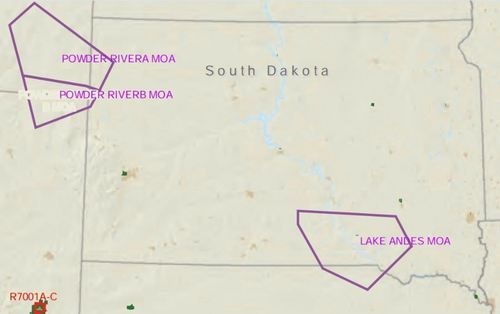
Some Mitchell-area residents were in a state of bewilderment last Saturday night after hearing a loud boom.
Though definitive information is scant, the boom could have been from a jet flying at supersonic speeds through a little-known military operations area.
The boom was heard around 11 p.m. and spawned calls to law enforcement officials in Mitchell and Mount Vernon, who did not determine a cause for the noise.
The National Weather Service office in Sioux Falls reported rain that night, but not much thunder. A lightning strike would be heard as a boom nearby where it hit, but would sound like a rumble from farther away.
Davison County Chief Deputy Steve Harr heard dispatchers discuss calls they received about a big boom. He heard reports of people who heard it in Mitchell, Mount Vernon and five miles northwest of Mount Vernon.
"This was a first for me," Harr said.
The noise may have been a sonic boom created by a jet flying faster than the speed of sound. The speed of sound varies with altitude and temperature, but is about 770 mph. The sonic boom would travel with the aircraft. Because the speed of sound can constantly change, it is possible to unintentionally break it.
The jet may have been flying through the Lake Andes Military Operations Area, an airspace used by the military for simulated air combat and complex missions, and practice maneuvers. It is the only such military operations area in the state, other than a small portion of the Powder River military air space in Montana and Wyoming that juts into South Dakota's northwest corner.
The Lake Andes MOA is not a restricted airspace. Private pilots can fly through the area but are urged to practice "see and avoid" flying. The MOA is not commonly known to non-pilots; in fact, Mitchell public safety officials interviewed for this story had never heard of it.
F-16s, B-1 Lancers and tankers are among the aircraft that use the Lake Andes MOA. F-16s and B-1 Lancers have the capability to go supersonic.
Lt. Col. Greg Lair, commander of the 175th Fighter Squadron of the South Dakota Air National Guard in Sioux Falls, said the Lake Andes MOA is used almost every day and often at night.
"We were flying in the evening Saturday night in that airspace," Lair said. "Knowing what the type of missions were, I highly doubt we were supersonic. If the atmospheric conditions were right, you might hear a sonic boom."
The jets are authorized to reach supersonic speeds, but only at high altitudes so that the noise doesn't reach the ground. Altitude is the greatest factor in reducing the intensity of sonic booms. Diving and turning of an aircraft can focus a sonic boom.
A humid environment, such as the one produced Saturday night due to rain, allows sound to travel farther with less of a reduction in its level. In nighttime conditions, sound waves bend downward.
"It's possible, but probably unlikely," Lair said. "We did have a large exercise this last weekend."
The Lake Andes MOA straddles the Missouri River in southern South Dakota and a portion of northern Nebraska. Its borders in South Dakota include cities such as Gregory, Winner, Stickney, Parkston and Wagner. Mitchell is within 20 miles of the MOA's northeast boundary.
There is a route, Military Training Route VR 510, that cuts near Vermillion before turning northwest. When it nears Sioux Falls, it turns northwest again and goes northwest past Mitchell. After skirting Wessington Springs and Chamberlain, it leads into the Lake Andes MOA.
The route is for low-level military training that's in excess of 250 knots, or about 278 mph. The route is used less frequently than the Lake Andes MOA, and aircraft are not authorized to go supersonic on the route.
"In the old days, they probably did," Lair said. "There is no practical reason to."
VR 510 is a defined corridor designed to stay away from towns, settlements and even large farms in an effort to abate noise.
"We try to be the best neighbor we can," Lair said. "Once we're flying up above, it's not a necessity to avoid the towns. We're avoiding them by altitude."



Reader Comments
to our Newsletter